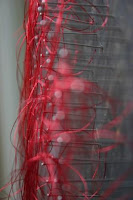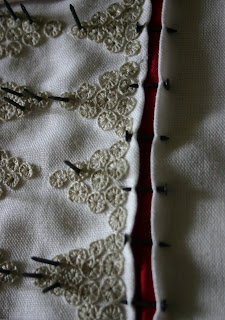 Culture Footprint for the Evangelical Alliance
Culture Footprint for the Evangelical AllianceLesley Sutton works as a freelance visual artist. She is a creative ‘jack of all trades’, having curated exhibitions, led community arts projects and tutored at universities, schools and colleges as well as making her own works.
Lesley has a degree in Visual Art and Culture and an MA in Fine Art. She received an award from the Arts Council in 2005 and a place on the Setting Up Scheme that supported artists in establishing creative businesses through residencies and professional development. She is passionate about encouraging others to tap into their own creativity and for the aesthetic to form part of our everyday living.
As a child what did you want to be when you grew up?All I ever wanted to be was a mum. Live in a cottage in the countryside, wear kaftans, have lots of children, knit, sew and dye cloth, bake and make jam. However God had other ideas and we have ministered for the past 27 years at Baptist churches in either inner city or suburbia. I have four beautiful children and God has met my childlike desires in many other ways.
How did you get involved in the arts?I have always enjoyed making; my mother spent hours painting watercolours when I was a child, and then when I had children of my own I encouraged lots of creative activity. I then volunteered at their primary school and became the arts co-ordinator for the junior school. I eventually decided to pursue my dreams and train professionally. After graduating I worked at the local Arts Centre as resident artist responsible for community engagement and slowly my work has evolved into its present form.
How do you engage the local community in the arts?Access, Participation and Ownership are the three key words I was taught to base my projects on. I believe that everyone should have access to the arts because everyone is creative in some form or another, for we are made in the image of a creative God. Art should not just be something done to people, but an activity that encourages participation, thereby increasing confidence, self esteem and ownership. This is a very difficult thing to get right as it is hard to not compromise on the ideas and the skills needed to create good contemporary work whilst also including others in the process.
What biblical text or narrative has inspired you in your work?Isaiah 53, He was pierced for our transgressions…and by His wounds we are healed. I am trying to make sense of the Paschal mystery that shows us that the risen Christ is glorious because of the wounds and bruises and not in spite of them.
Gives us a theological reflection on the arts.There is a disturbing separation between the spiritual and the material in our Western way of living. Disconnectedness between the individual and community, a dualism of mind and spirit. Throughout my lifetime the Word has been the primary from of language while the language of the senses and of the spirit are often disregarded. This dualism has affected the Church. Though we have lively worship songs, guitars and drum kits, ‘proclamation’ has been understood to be the main emphasis of communication, sadly, at the expense of image, materiality, mystery and wonder. Our Baptist denomination has grown significantly because of this ‘preacher, pastor, worship’ emphasis and has suited well the generation I grew up in, but in this new postmodern era, things are changing and there is a growing cultural divide between church and society that is causing us to readdress the way we do church.
In the last few years this disembodied theology is being challenged to rethink some of its ingrained practices and to make space for faith to be explored, to be more organic, mystical and spiritual and less defined and dogmatic. A re-connection is occurring with a visual and material language that utilises participation and ritual. As an artist and a Christian this excites me, as I believe that now is the time for creatives and theologians to work together to build a new language, to reconnect with some of the pre-reformational expressions of church that utilised all the senses, in both ritual performance and sacred spaces.
How can the arts be used in celebrating the significant moments in life?By ‘making it special’, be it selecting or embellishing significant objects, words or actions. It can help to form sacred space and moments that act as physical signifiers of a deeper spiritual work in our lives. These creative acts then form lasting reminders of what God has done in our lives and act as markers along the journey of life; as with the twelve stones taken from the Jordan in Joshua 4.
Does the Church engage enough with society through the arts?Although much is being done, there is always more to do. The pre-Reformation Church engaged with society through image, sculpture, story and ritual and we need to re-learn to share God’s mission to this world by utilising all the senses rather than limiting ourselves to the word.
What is your dream for society?To be a place of beauty, of hope, of dreaming, of peace and of love; a reflection of heaven.
What makes you angry?The increase in student fees!!
How do the arts bring wellbeing to the world?The arts help us to make sense of our lives by creating a language of the heart and not just of the mind. Creative expression is freeing, and at its best provides a safe place to explore many aspects of life, such as love, loss, change and journey. It teaches us to look for beauty in all things, to pause and examine the minutiae of life as well as the spectacular. When these expressions are shared it brings about a deeper sense of community and wellbeing, nurturing a universal language of the soul.











